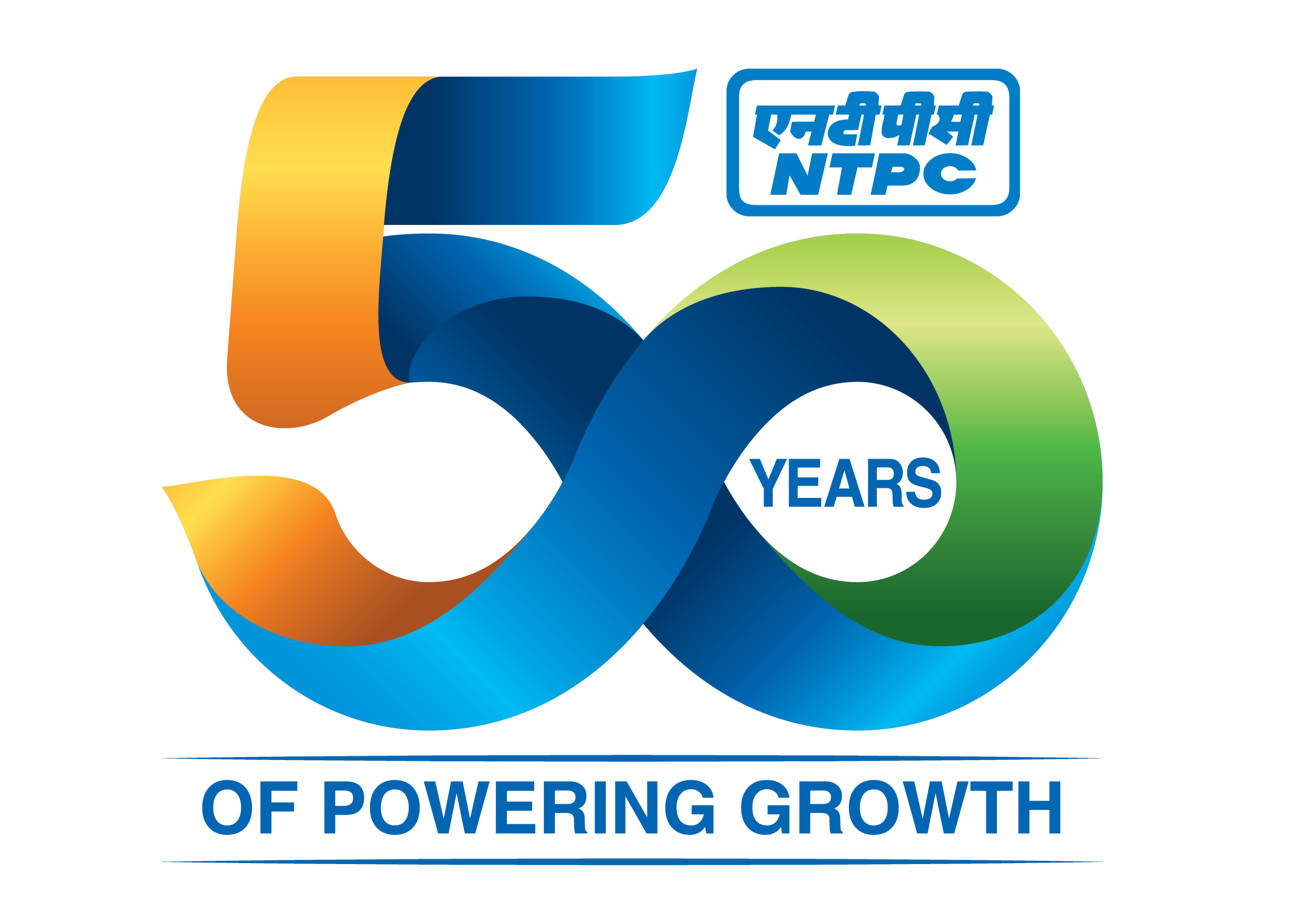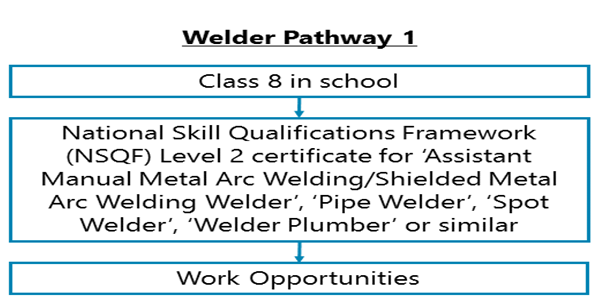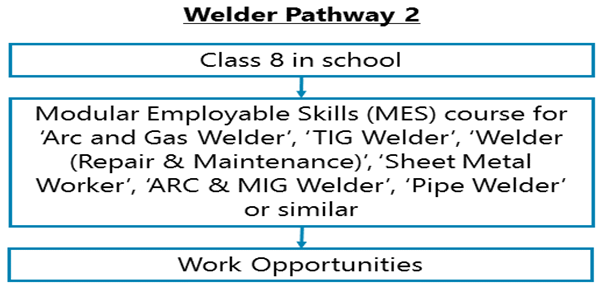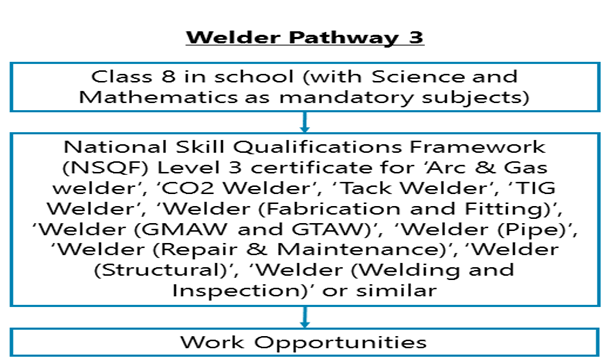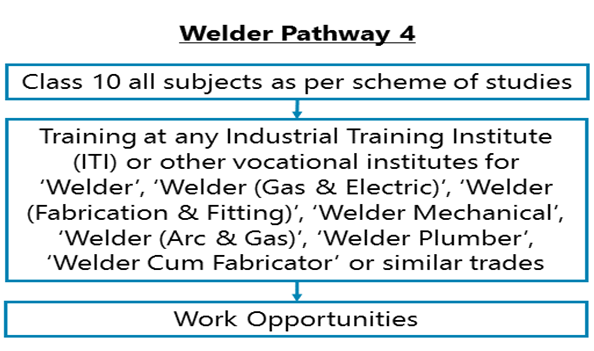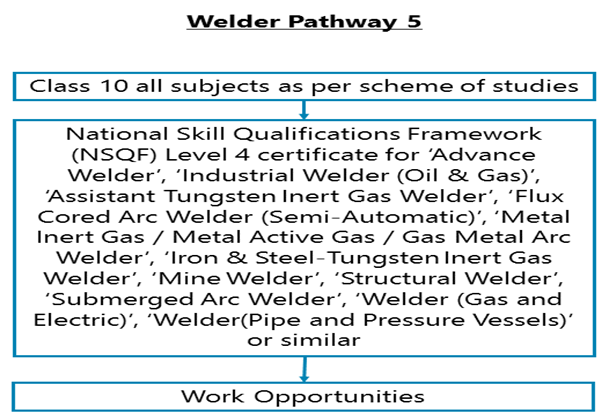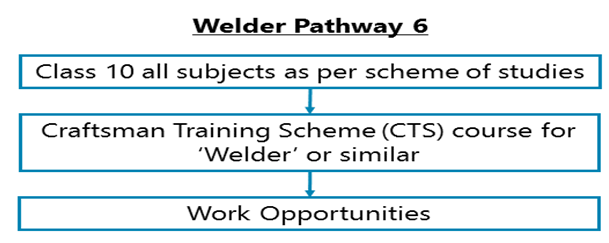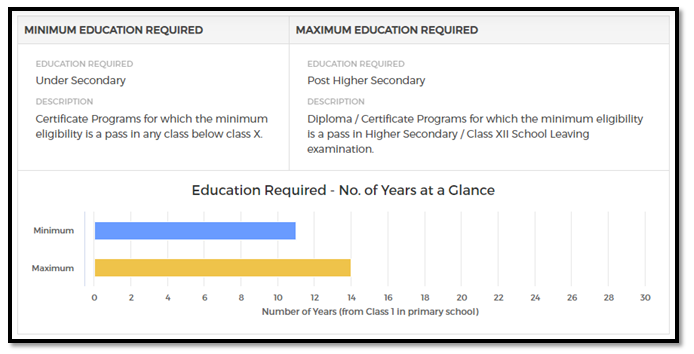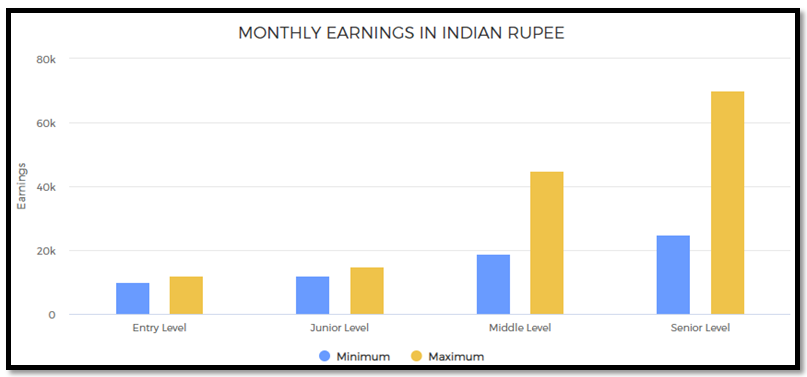Welder
Entry Level Qualification
8
Career Fields
Plumber, Fitter, Electrician, Welder & Carpenter
For Specially Abled




Career Entrance Exam
About Career
1. As a Welder, you will be involved in welding of various material components (materials like steel/stainless steel, copper/copper alloys, aluminium/aluminium alloys, cast iron, other metals etc.) and using them for making tools, industrial machinery, and machine parts.
2. You will be working with power welding tools, electric tools, machine tools, cutting tools, magnetic devices etc. You will have to ensure that the machine settings and speeds are adjusted and calibrated before starting to work.
3. You will be working under supervisors, foremen or persons-in-charge and study operational drawings, approved illustrations or sketches to find out what you need to do and how.
4. You will also need safety glasses, face masks and covered shoes at your workplace. You will have to follow necessary rules and established safety standards while working, as welding warehouses are typically areas with sharp tools, welding gases (due to heating) and electric devices.
Key Roles and Responsibilities:
As a Welder, you will be engaged with one or more of the following roles and responsibilities: -
1. You will read study and analyze engineering drawings, specifications, sketches and illustrations received from engineers, supervisors, foremen or other persons-in-charge to understand how you will perform your work.
2. You will set up a proper plan of welding activities that you will need to perform as per the given details and specifications.
3. You will obtain all the necessary materials, tools and equipment required for your plan of action.
4. You will set and adjust machine controls, machine guards, speeds and settings and check them thoroughly before preparing to work.
5. You will ensure that you have adequate personal protective equipment like safety glasses, face masks and covered shoes and all kinds of jewellery or other material removed (which can get entangled with the machines) before starting to work.
6. You will prepare for the welding activities by mounting, positioning and correctly setting a vast range of instruments like work tools, welding tools, power tools, and work-holding devices.
7. You will operate the machine tool controls maintaining all safety rules following the established protocol.
8. You will stop the machine in both normal and emergency situations appropriately following the right procedure for restarting after an emergency if required.
PARTICULARS | DESCRIPTION |
Name | Welder |
Purpose | Repair Metal Products |
Career Field | Plumber, Fitter, Electrician, Welder & Carpenter |
Required Entrance Exam | No Entrance Exam |
Average Salary | 150000 - 200000 Rs. Per Year |
Companies For You | Railways, Iron and Steel, Gem & Jewellery & Many More |
Who is Eligible | Any One |
Career Entry Pathway
Class 8 in school – NSQF Level 2 course for ‘Assistant Manual Metal Arc Welding/Shielded Metal Arc Welding Welder’ or related courses
After completing Class 8 in school, you can go for National Skill Qualifications Framework (NSQF) Level 2 certificate for ‘Assistant Manual Metal Arc Welding/Shielded Metal Arc Welding Welder’, ‘Pipe Welder’, ‘Spot Welder’, ‘Welder Plumber’ or similar courses. The total number of training hours is 300-600
Class 8 in school – MES course for ‘Arc and Gas Welder’
After completing Class 8 in school, you can go for Modular Employable Skills (MES) course for ‘Arc and Gas Welder’, ‘TIG Welder’, ‘Welder (Repair & Maintenance)’, ‘Sheet Metal Worker’, ‘ARC & MIG Welder’, ‘Pipe Welder’ or similar courses under the Skill Development Initiative Scheme (SDIS) framework approved by National Council of Vocational Training (NCVT). The total number of training hours is around 250-700
Class 8 in school – NSQF Level 3 Training in ‘Arc & Gas welder’ or related courses
After completing Class 8 in school with Science and Mathematics as mandatory subjects, you can go for National Skill Qualifications Framework (NSQF) Level 3 certificate for ‘Arc & Gas welder’, ‘CO2 Welder’, ‘Tack Welder’, ‘TIG Welder’, ‘Welder (Fabrication and Fitting)’, ‘Welder (GMAW and GTAW)’, ‘Welder (Pipe)’, ‘Welder (Repair & Maintenance)’, ‘Welder (Structural)’, ‘Welder (Welding and Inspection)’ or similar. The total number of training hours is 300-1980
Class 10 all subjects as per scheme of studies – training at an ITI or similar institute for ‘Welder’
After Class 10, you can go for training at any Industrial Training Institute (ITI), National Skill Training Institute (NSTI), Regional Vocational Training Institute (RVTI), National Vocational Training Institute (NVTI), Industrial Training Center (ITC), Workshop Training Institute (WTI) or other vocational institutes for ‘Welder’, ‘Welder (Gas & Electric)’, ‘Welder (Fabrication & Fitting)’, ‘Welder Mechanical’, ‘Welder (Arc & Gas)’, ‘Welder Plumber’, ‘Welder Cum Fabricator’ or similar trades. You will sit for All India Trade Test (AITT) to get a National Trade Certificate (NTC) after this course. This exam is held twice a year in the months of February and July
Class 10 all subjects as per scheme of studies– NSQF Level 4 Training in ‘Advance Welder’ or related courses
After Class 10, you can go for National Skill Qualifications Framework (NSQF) Level 4 certificate for ‘Advance Welder’, ‘Industrial Welder (Oil & Gas)’, ‘Assistant Tungsten Inert Gas Welder’, ‘Flux Cored Arc Welder (Semi-Automatic)’, ‘Metal Inert Gas / Metal Active Gas / Gas Metal Arc Welder’, ‘Iron & Steel-Tungsten Inert Gas Welder’, ‘Mine Welder’, ‘Structural Welder’, ‘Submerged Arc Welder’, ‘Welder (Gas and Electric)’, ‘Welder(Pipe and Pressure Vessels)’ or similar courses. The total number of training hours is 300-600
Class 10 all subjects as per scheme of studies – CTS training for ‘Welder’
After Class 10, you can go for Craftsman Training Scheme (CTS) course for ‘Turner’ or similar which follows National Skills Qualification Framework (NSQF) Level 4 guidelines.
Required Qualification & Competencies
After class 10, you can go for:.
1. ITI Training courses.
2. NSQF Training courses.
3. CTS courses.
4. MES courses.
5. National Apprenticeship Certificate (NAC) after ITI or Class 10
After Class 11-12, you can go for NSQF Level 5 training and certificate courses only after you pass any other certificate course or have at least 3 months of welding (manual/shielded metal arc welding) experience.
Compentencies Required
1. You should have interests for Realistic Occupations. Realistic occupations involve more practical and hands-on activities than paperwork or office work. Realistic occupations often involve physical activities for getting things done using various tools and equipment.
2. You should have interests for Conventional Occupations. Conventional occupations involve repetitive and routine tasks as well as fixed processes or procedures for getting things done. These occupations involve working more with data, systems, and procedures and less with ideas or creativity.
3. You should have knowledge of Mechanical Engineering & Technology - Knowledge of Mechanical Engineering & Technologies which include design, development, testing, manufacturing, installation, operations, repair and maintenance of different machinery, devices, equipment, and tools.
4. You should have Machine Repair and Maintenance Skills - performing repair and maintenance of different machines, equipment, and devices.
5. You should have Operating Skills - operating various machines, equipment, devices and systems.
6. You should have Operations and Process Analysis Skills - Skills in analysis of operations and processes such as industrial manufacturing, chemical processing, etc. so as to device better and more efficient operational processes and systems.
7. You should have Process and Operation Controlling Skills - controlling processes and operations of various machines, equipment, devices and systems using different types electrical and electronic control instruments and systems.
8. You should have Skills in Managing Material Resources - Skills in sourcing, buying, storing, and use of appropriate raw materials, machines, equipment, and devices for various purposes such as industrial manufacturing, building construction, etc.
9. You should have Problem Solving Skills - analysis and understanding of problems, evaluating various options to solve the problems and using the best option to solve the problems.
10. You should have Quality Control Analysis Skills - conducting tests and inspections of products, services, or processes to evaluate quality or performance.
11. You should have Arm-Hand Steadiness - The ability to keep your hand and arm steady while moving your arm or while holding your arm and hand in one position.
12. You should have Manual Dexterity - The ability to quickly move your hand, your hand together with your arm, or your two hands to grasp, manipulate, or assemble objects.
13. You are always or mostly careful about your actions and behaviour.
14. You are practical always or in most situations.
15. You are always or mostly disciplined in your action and behaviour.
16. You are always or mostly organized in your day-to-day life and activities.
Career - Job Opportunities & Profiles
You may get job roles like:
1. Welder
2. Industrial Welder (Oil & Gas)
3. Arc & Gas welder
4. Assistant - Manual Metal Arc Welding
5. Shielded Metal Arc Welder
6. Tungsten Inert Gas Welder
7. CO2 Welder
8. Construction Welder
9. Welder (Gas and Electric)
10. Flux Cored Arc Welder
11. Mine Welder
12. Pipe Welder
13. Welder(Pipe and Pressure Vessels)
14. Spot Welder (Gem & Jewellery)
15. Structural Welder
16. Submerged Arc Welder
17. Tack Welder
Some of the industries that will require your services are:
1. Industrial Products / Heavy Machinery
2. Construction / Engineering / Cement / Metals / Plumbing
3. Automobile / Auto Anciliary / Auto Components
4. Oil and Gas / Energy / Power / Infrastructure
5. Railways
6. Iron and Steel
7. Gem & Jewellery
8. Water Treatment / Waste Management
9. Ship / Marine Vessel Construction
Career Growth
You may grow through roles like Senior Welder, Senior MIG Welder, Welding Technician, Master Technician, Chief Welder, Workshop Supervisor etc.
Salary Offered
1. At the beginning of your career as a Trainee, you will be earning about Rs. 10,000-12,000 per month.
2. After 2-3 years of experience, you will be getting about Rs. 12,000-15,000 per month.
3. When you acquire about 7-8 years of experience, you can earn about Rs. 19,000-45,000 or even more per month.
4. After 12-15 years of experience, you can earn about Rs. 25,000-70,000 or more per month.
5. There is a lot of demand for trained MIG (metal inert gas), TIG (tungsten inert gas), arc, 4G & 6G (angles at which plates or pipes are welded) Welders abroad, mostly in Middle Eastern and African countries. After having 2-5 years of experience, as a Welder, you can earn about Rs. 70,000 – 80,000 or more per month. After having 8-12 years of experience, you may earn about Rs. 1, 20, 000-1, 70, 000 or even more per month.
Monthly Earnings In Indian Rupee
1. Entry level: 0 - 2 years of work experience
2. Junior Level: From 1 to 12 years of work experience
3. Mid-Level: From 5 to 20+ years of work experience
4. Senior Level: From 10 to 25+ years of work experience (there could be exceptions in some high-end technical, financial, engineering, creative, management, sports, and other careers; also in the near future, people will reach these levels much faster in many careers and in some careers, these levels will have no meaning as those careers will be completely tech skill driven such as even now, there is almost no level in a Cyber Security Expert’s job)
Work Activities
1. Inspecting equipment, systems, structures, and materials - Inspecting equipment, systems, structures, and materials to ascertain quality, performance, defects, causes of errors, etc.
2. Operating machines, equipment, devices, systems and processes - Using various methods and techniques to operate machines, equipment, devices, systems, and processes in industrial and other settings.
3. Performing physical activities - Performing physical activities that require the use of your arms and legs and moving your whole body, such as climbing, lifting, balancing, walking, stooping, and handling of materials.
4. Installing, repairing and maintaining equipment, devices, and products - Installing, servicing, repairing, and maintaining equipment, devices, and products for usages in homes, workplaces, and industrial settings.
5. Handling and moving objects and materials - Using hands or otherwise use physical strength to handle and move objects and materials; maneuver, install, lift, place, manipulate, etc.
6. Communicating with co-workers and others - Communicating with people in writing, verbally or otherwise inside your workplace and various other people who have professional relationships with your place of work including vendors, government officials, etc. or with people at large.
7. Working in a team - Working in a team of people; developing team; maintaining professional relationships among team members.
Future Prospects
You can expect a bright future in this field as the industry growth prospects are encouraging. Due to rapid technological advancements, the prospects of mechanical engineering are expanding. On top of that, Prime Minister Narendra Modi’s Make in India campaign is boosting the Indian manufacturing sector too.
The Manufacturing sector in India has a potential to touch the mark of 1 trillion US Dollars by 2025. India is predicted to become the world’s 5th largest economy and reach the 4.7 trillion US Dollars mark.
Future Prospects At a Glance

